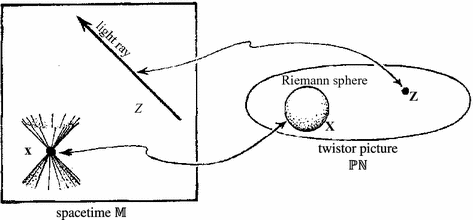I was down in Princeton last Thursday, and attended a wonderful talk by Witten, which I’ll try and explain a little bit about here. Presumably within a rather short time he’ll have a paper out on the arXiv giving full details.
The talk concerned Chern-Simons theory, the remarkable 3d QFT that was largely responsible for Witten’s Fields medal. Given an SU(2) connection A on a bundle over a 3-manifold M, one can define its Chern-Simons number CS(A). This number is invariant under the identity component of the group of gauge transformations $\mathcal G$, and jumps by 2π times an integer under topologically non-trivial gauge transformations. The QFT is given by taking CS(A) as the action. The path integral
$$Z(M,k)=\int_{\mathcal A/\mathcal G} dA e^{ikCS(A)}$$
is well-defined for k integral and gives an interesting topological invariant of the 3-manifold M. One can also take a knot K in M, choose an irreducible representation R of SU(2) of spin n/2, and then define a knot invariant by
$$Z(M,K,k,n)=\int_{\mathcal A/\mathcal G} dA e^{ikCS(A)}hol_R(K)$$
where $hol_R(K)$ is the trace of the holonomy in the representation R, around the knot K (this is the Wilson loop).
To simplify matters, consider the special case $Z(K,k,n)=Z(S^3,K,k,n)$, which can be used to study knots in $\mathbf R^3$.
These knot invariants can be evaluated for large k by stationary phase approximation (perturbation theory), and for arbitrary k by reformulating the QFT in a Hamiltonian formalism, and using loop group representation theory and the Verlinde (fusion) algebra.
One thing that has always bothered me about this story is that it has never been clear to me whether such a path integral makes sense at all non-perturbatively. At one point I spent a lot of time thinking about how you would do such a calculation in lattice gauge theory. There, one can imagine various (computationally impractical) ways of defining the action, but integrating a phase over an infinite dimensional space always looked problematic: without some other sort of structure, it was hard to see how one could get a well-defined answer in the limit of zero-lattice spacing. In simpler models with similar structure (e.g. loops on a symplectic manifold), similar problems appear, and are resolved by introducing additional terms in the action.
What Witten proposed in his talk was a method for consistently defining such path integrals by analytic continuation. The idea is to complexify, working with SL(2,C) connections and a holomorphic Chern-Simons functional, then exploit the freedom to choose a different contour to integrate over than the contour of SU(2) connections. By choosing a contour that is not invariant under topologically non-trivial gauge transformations, and only modding out by the topologically trivial ones, Witten also managed to define the theory for non-integral k, making contact with a lot of mathematical work on these knot invariants, which treats them a Laurent polynomials in the square root of
$$q=e^{2\pi i/(k+2)}$$
The main new idea that Witten was using was that the contributions of different critical points p (including complex ones), could be calculated by choosing appropriate contours $\mathcal C_p$ using Morse theory for the Chern-Simons functional. This sort of Morse theory involving holomorphic Morse functions gets used in mathematics in Picard-Lefshetz theory. The contour is given by the downward flow from the critical point, and the flow equation turns out to be a variant of the self-duality equation that Witten had previously encountered in his work with Kapustin on geometric Langlands. One tricky aspect of all this is that the contours one needs to integrate over are sums of the $\mathcal C_p$ with integral coefficients and these coefficients jump at “Stokes curves” as one varies the parameter in one’s integral (in this case, x=k/n, k and n are large). In his talk, Witten showed the answer that he gets for the case of the figure-eight knot.
Mathematicians and mathematical physicists have done quite a bit of work on SL(2,C) Chern-Simons, and studying the properties of knot-invariants as analytic functions. I don’t know whether Witten’s new technique solves any of the mathematical problems that have come up there. He mentioned the relation to 3d gravity, where the relationship between Chern-Simons theory and gravity in the Lorentzian and Euclidean signature cases evidently still remains somewhat mysterious. Perhaps his analytic continuation method may provide some new insight there. It also may apply to a much wider range of QFTs where there are imaginary terms in the action, making the path integral problematic. I’d be very curious to understand how this works out in some simpler models, such as the loop space ones. In any case, it appears to be a quite beautiful new idea about how to define certain QFTs via the path integral.
Update: Witten’s slides for the talk are available here, video here. For slides from other talks at the workshop the talk was part of, see here.


